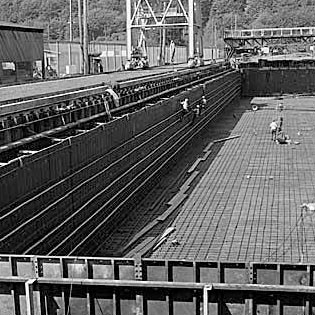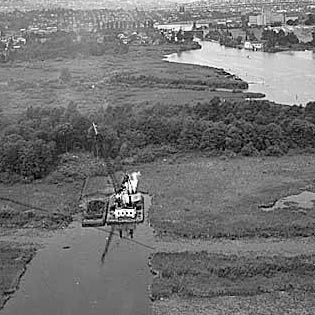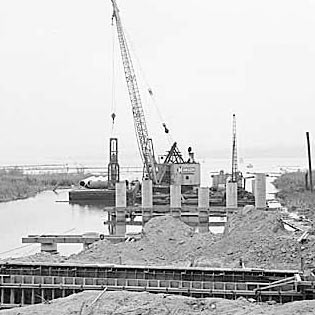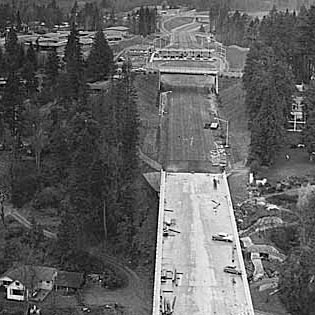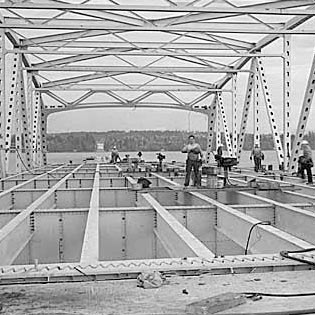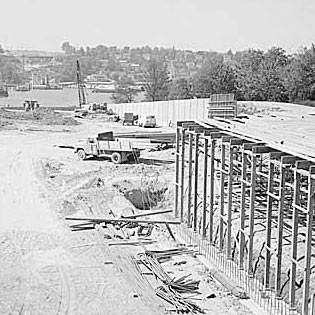AUDIO
MP3 Download: Listen to Dean Bitney, a native of Mercer Island, talk about the construction of the SR 520 Bridge.
MP3 Download: Listen to Roxanne Bitney, a former SR 520 toll plaza employee, talk about working on the SR 520 Bridge.
MP3 Download: Listen to Archie Allen, Bridge Maintenance and Operations Superintendent at the Washington State Department of Transportation, talk about bridge and pontoon contruction.
RESOURCES
- Evergreen Point Bridge Written Narrative (pdf 8.3mb)
- Evergreen Point Bridge - Field Records (pdf 480 kb)
Links to external websites do not constitute endorsement by WSDOT of the linked websites or the opinions, information, products or services contained therein.
A t 7,578 feet (1.4 miles) long, the old Evergreen Point Bridge held the title of the longest floating bridge in the world from the time it opened in 1963 until the new SR 520 floating bridge opened in 2016. The Evergreen Point Bridge’s unique design incorporated a drawspan with movable pontoons, which allowed for the passage of ships and other maritime vessels.
The floating section of the bridge featured 33 prestressed concrete pontoons. Interior cell walls were 6 inches thick, and the exterior pontoon walls were 9 inches thick. The largest pontoon was 360 feet long and weighed 6,700 tons. They were fastened to the lake bottom with 77-ton reinforced concrete anchors and 2 ¾-inch steel cables.
Near the Evergreen Point Bridge’s midpoint were two steel lift drawspans that flanked two 16-foot-long movable pontoons. The drawspans were designed to be raised 7 feet 2 inches, which allowed the movable pontoons to retract. Once opened, the span had a 200-foot-wide clearance for ships and other vessels. The drawspans retracted into hourglass-shaped sections on both sides.
The minimum height of the floating bridge’s roadway above water was 7.75 feet, where the roadway sits directly on the floating pontoons. The maximum roadway height was 59 feet where the road surface was elevated above the concrete pontoons at the east end of the floating structure. The top of the railing sat about four feet above the roadway surface. Approximately 11.8 million pounds of reinforcing steel was used to construct the bridge. Once constructed, the bridge in its entirety weighed 114,000 tons.
Construction of the old Evergreen Point Bridge commenced on Aug. 29, 1960. The construction management team made its field headquarters where the University of Washington Shell House is today. Early discovery of deeper than expected mud near Madison Park forced more extensive dredging and b
Seattle contractors made the bridge pontoons, superstructures and anchors at sites in the SoDo neighborhood south of downtown Seattle and on Lake Union. The pontoons were towed to Kennydale Moorage on the eastern shore of Lake Washington, in Renton, for storage. By early 1963 the anchors and pontoons were in place and the floating portion of the bridge was assembled that summer. The new corridor opened for travelers in late August 1963, 837 days after construction began.
Eastside drivers reached the bridge on new access roads at 84th Avenue Northeast, 104th Avenue Northeast, and State Highway 2A, near 116th Avenue Northeast. Drivers coming from the west got on the bridge from the Montlake neighborhood at Lake Washington Boulevard and Montlake Boulevard. The bridge toll plazas were placed between 84th Avenue Northeast on the eastern lakeshore, with seven tollbooths to accommodate anticipated traffic.
On the same day the bridge opened (Aug. 28, 1963), Martin Luther King led his famous civil rights March on Washington, D.C. The "Official Opening” was attended by scores of local and national dignitaries. Gov. Rosellini, as Chairman of the Washington State Toll Bridge Authority, presided over the dedication and ribbon-cutting ceremony.
In its waning years, the aging floating bridge was found to be vulnerable to failure in a severe windstorm, and the fixed bridges along the corridor no longer met current seismic standards and could have collapsed in an earthquake. For these reasons, the bridge was replaced by a new floating bridge, which opened to traffic in April 2016.
